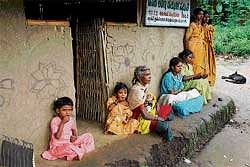
“There is not a single graduate from the Jenukuruba community,” says a tribal leader Ramu, hailing from a haadi or tribal settlement located in Hunsur taluk inside the Nagarahole National Park.
That a tribal community with a population of 60,000 doesn’t have a single degree holder as the country celebrates its 65th Independence Day is an indicator of the deprivation the community has suffered.
Spread over Mysore, Kodagu and Chamarajanagar districts, Jenukurubas and Koragas are two primitive tribes - the original settlers of forests - in the state. The 20,000 population of Koragas, known to carry night soil, reside in Dakshina Kannada, Udupi and parts of Kerala. Their condition isn’t much better - they have a few, countable number of graduates.
Let alone education, many of the tribals are yet to receive even BPL ration cards. During a visit to Maanemoole Haadi of D B Kuppe grama panchayat in the Rajiv Gandhi National Park, it came to light that government schemes such as provision of BPL ration cards are yet to reach 150 of 600 families. Apart from lack of facilities, the tribals also lack political representation and nearly zero social esteem.
Sreekanth, convenor of an NGO, questions the pathetic backwardness in education despite introduction of the Integrated Tribal Development Programme (ITDP) that was initiated way back in 1978 in Karnataka, Kerala, Tamil Nadu and West Bengal, to bring tribals to the mainstream.
In retrospect, north-eastern states enjoy the privilege of being covered by the Sixth Schedule of the Constitution, where interference from the state government is limited and administration rests with grama panchayats comprising tribals. Even Central India consisting of Madhya Pradesh, Bihar, Chhattisgarh, Jharkhand, northern parts of Andhra Pradesh and Maharashtra have the advantage of being under the Fifth Scheduled Area, which provides grama panchayats to function under an advisory council.
However, even with a population of four lakh persons, primitive and forest tribes in Karnataka are yet to get their Constitutional rights. With the state government failing to, or unwilling to seek Scheduled Area status, tribals here are constantly facing threat to their livelihood due to the lack of rehabilitation policies.
Govts failed their cause
While Yashodhara Dasappa, then social welfare minister in the cabinet of chief minister S Nijalinappa, initiated measures to build ashrama schools and provide homes for the forest dwellers, the tribes were failed by successive governments.
Tribal leader Ramu, who has been working for several years in association with NGOs, opines that their community doesn’t need sympathy. Instead, what they need is opportunity. Agreeing with the idea is Prof Muzzafar H Assadi of the department of political science, University of Mysore, who says that government policies haven’t reached the tribals and there is no scope for development.
“For both the government and NGOs, tribals have become a commodity. If ITDP hasn’t been able to provide basic facilities, nothing will change for another hundred years,” says Prof Assadi.
He mentioned that the focus has only been on providing education up to school level. “After that, what should a tribal do? How should he earn? We have to plan for all these factors,” he asserts.
“They are not able to buy 1,500 calories of food per day,” he added.
A toddler’s death
After the death of a three-year-old boy in Maanemoole Haadi recently, his grandmother summed up the situation of the tribals thus: “I have eaten roots found in the forest and have given birth to 11 children. None of my children died. But now, even after consuming medicines given by the government, my grandson is dead.”